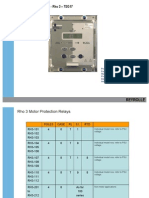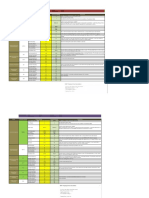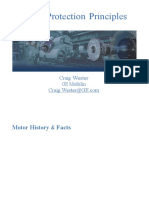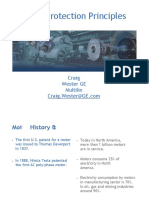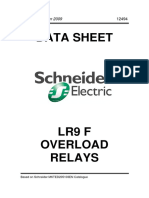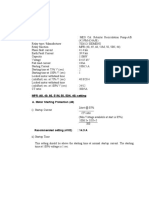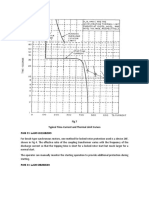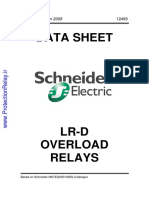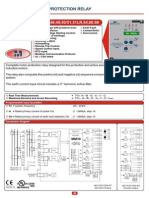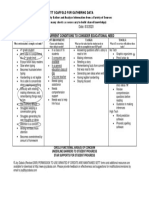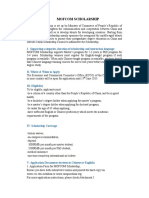RHO MANUAL
Application guide
1.
SELECTION OF PROTECTION FUNCTIONS
2.
MULTIFUNCTION APPLICATIONS
2.1
C.T. ratio
2.2
C.T. ratio thermal overload setting
2.3
NPS weighting factors
2.6
th
ts
Cooling time constant, tc
2.7
Hot/cold curve ratio
2.4
2.5
Heating time constant,
Starting time constant,
2.8
Thermal capacity alarm setting
2.9
Load increase alarm setting
2.10
Thermal restart inhibit setting
2.11
Motor start current (ISTART)
2.12
Motor stop current
2.13
Stall and locked rotor protection
(ts1 and ts2 settings)
2.14
Circuit breaker fail protection
(time delays 1 and 2)
3. OVER/UNDER CURRENT PROTECTION
3.1
Phase fault alarm setting (IHA) and time delay tHA)
3.2
Phase fault trip setting (IHS) and time delay (tHS)
3.3
Earth fault alarm setting IEA and time delay (tEA)
3.4
Earth fault trip setting (IEF) and time delay (tEF)
3.5
Earth fault inhibit setting (IEI)
3.6
Undercurrent protection
4. PHASE UNBALANCE PROTECTION
5. NUMBER OF STARTS PROTECTION
6. OPTIONAL TEMPERATURE INPUTS
6.1
RTD inputs
6.2
Thermistor inputs
6.3
Detector failure protection
6.4
Detector gating
7.
OTHER FEATURES
7.1
Trip circuit supervision
40
�RHO MANUAL
Application guide
1
SELECTION OF PROTECTION
2.1
C.T. ratio
FUNCTIONS
The C.T. ratio should be chosen as equal to or the next
The Rho 3 series of relays incorporate a number of
standard above the motor full load rating in this case
protection functions for the protection of induction and
choose 100 amp primary. The secondary could be
synchronous motors and may be scaled to suit the
either 1 or 5 amp. The modern tendency is to
particular application. When selecting the relay and
standardise on 1 amp, so choose a 100/1 ratio.
functions some general considerations are as follows:The relay thermal full load setting is
g
Motor load eg pump, fan, compressor,
Frequency of operation
Whether the motor incorporates RTD devices
Motor FLC
= 86.2 x 1 = 0.86 amps.
CT Ratio
conveyor etc.
to monitor winding and bearing temperatures
g
Whether the motor incorporates a speed switch
Motor rating
2.2
100
C.T. ratio thermal overload setting
It is usual to choose a thermal overload setting above
which the relay starts timing out, of 105%. This allows
full utilisation of the output rating of the motor. In this
case, this equates to 1.05 x 0.86 = 0.903. As the C.T.
When applying the Rho 3 relay, individual protection
functions may be enabled as required and are defined
secondary is 1 amp the thermal overload (Iq) should be
set to 0.90.
in detail in the Description of Operation.
Alternatively, if it is known that the rating of the motor is
2
MULTIFUNCTION APPLICATIONS
As a typical example, consider the protection of a 4
pole induction motor with the following parameters:-
well in excess of the requirements of the drive, and the
motor load current is therefore less than the motor rated
current, a setting equal to or less than 1.0 can be
employed. The thermal overload is then being
employed to protect the drive and over protects the
Rated voltage:
6.6KV
Rated output power :
800KW
Power factor:
0.85
Efficiency :
95.5%
Starting:
Direct on line
The Rho 3 relay computes the positive and negative
Controlled by:
Vacuum circuit breakers
sequence components from the three phase input line
Locked rotor current:
5 x full load
currents. These are used to generate an equivalent
Run-up time:
4 secs
motor.
2.3
NPS weighting factors
thermal current Ieq which is calculated from the
equation.
Safe stall times:
Starting (cold):
11 secs
Running (hot):
7 secs
leq =
I 12 + KI 22
Permitted number of
Starts per period:
2 per hour (hot)
Where I1 = Positive phase sequence current
I2 = Negative phase sequence current
Input power =
Output
P.F x efficiency
800
0.85 x 0.955
K = Constant = NPS weighting factor
K is settable on the relay from 0 to 10. If the motor
= 985KVA
supplier or manufacturer provides data giving the
Full load current =
KVA
3 KV
=
985
1.73 X 6.6
= 86.2 amps
machine negative sequence withstand (NPS weighting
factor), this figure should be used. If no figure is
available, it is recommended that K be set to 4. Should
this setting give nuisance tripping in service, the stored
The starting current can be taken to be the same as the
records of the Rho should be studied and the motor
locked rotor current ie, 5 x 86.2 = 431 amps.
manufacturer consulted before decreasing the
weighting factor.
�Negative sequence currents give rise to additional rotor
2.6
Cooling time constant,
tc
heating, they produce a substantial rotor current at
approximately twice system frequency. At this
When a motor is switched off the rotor de-cellerates and
frequency, skin effects in rotor bars can cause
eventually stops. During the run-down state and
significant rotor heating. Usual thermal limit curves
standstill state the motor windings will cool down but
supplied by machine manufacturers assume positive
they are likley to have a different time constant for
sequence currents only from a perfectly balanced
cooling than for heating up during running. This is
supply. Rho relays are settable to give complete motor
because during the start-up and running state there is
protection under all supply conditions.
forced cooling experienced by the windings due to the
2.4
Heating time constant,
th
rotor movement.
The cooling time constant of the motor is therefore
The relay heating time constant th is settable from 0.5
always longer than the heating time constant for
to 100 minutes in 0.5 steps, figure 1 shows the family of
running. The factor of tc/th is not specified by the motor
curves. Using the example of the motor parameters
manufacturer very often. Typical factors are 5 to 10 x,
quoted under item 2 above and reading values from
however for large motors which are totally enclosed and
also ones that normally rely heavily on forced cooling
Figure 1:At a locked rotor current of 5 x FLC (which is about the
starting current) and a run-up time of 4 seconds and
due to motion of the rotor, the factor can be as high as
60x.
allowing two consecutive starts ie 8 seconds total run-
The net result of choosing a high value for tc is that it
up time, the th value from figure 1 is just over 3
may not be possible to start the motor immediately after
minutes. As the safe stall time from cold is 11 seconds,
a shut down.
the th value could be set to 5. he stall time from hot, ie
7 secs gives a th value of 3. If this lower value of 3 is
chosen, there is the possibility of nuisance tripping after
the motor has been in service for some time with longer
run-up times and higher currents. It would be better to
select the value of 5 which allows two starts in quick
succession. Of course, if the actual th heating time
In this example, the cooling time constant has not been
specified either as a time constant or as a multiple of its
heating time constant. We will therefore choose 10 x,
which is the default.
2.7
Hot/cold curve ratio
(hot spot weighting)
constant of the motor is given by the manufacturer, then
The Rho 3 relay allows adjustment of the Hot/Cold curve
this figure could be set on the relay.
2.5
Starting time constant,
ts
When a motor is running at full design speed, the
airflow and ventilation is designed to give optimum
cooling. On starting, the current is nearly the stall value
but the ventilation is reduced. If this time constant is
known, it can be set on the relay. If not, then set the
time constant (settable 0.5 to 1.5 of the heating time
constant th) to 1.0, ie the same as th.
The time constant switches from th to ts as current
levels above the set value of ISTART. When ts is set
below 1.0 x Iq, this feature assists in ensuring that a
stall on start up does not exceed the motor withstand
time. However where the stall withstand time (e.g from
hot) is less than the run-up time it is still necessary to
provide a tachometric speed switch on the rotor shaft
operating time ratio. This allows a weighting factor for
motor winding hot spots to be applied. Motors with
onerous hot spots are overdesigned for normal load and
by selecting a high value of H/C it allows advantage to
be taken of the overdesign for overload, ie longer
operating time. Selecting the Hot/Cold ratio (H/C) to
100% (ie a high weighting factor) results in the relay
indicating 100% thermal capacity being available when
the motor has been running at full load for a sufficiently
long time to reach steady after a motor-switch on. The
hot and cold operating time curves are the same.
A low weighting factor would be 5%. Switching H/C to
off is equivalent to H/C = 0. In this case, when
operating at full load, the relay would indicate little
thermal capacity available, eg 100% used. The hot
operating time curve is then much faster than the cold.
as described previously. The time constant switches
An indication of the motor hot spot characteristic is the
from th to ts at current levels above the set valve of
ratio of hot stall withstand to the cold withstand, th/tc.
ISTART
With no hot spots (eg a cable) this ratio would be = 1.
42
�RHO MANUAL
Application guide
In our example th/tc = 7/11 = 0.64. The H/C setting to
2.8
Thermal capacity alarm setting
be applied to the relay is then established from the
This setting is expressed as a percentage of the
following:
thermal capacity set as above. It is settable 50 to 100%
th/tc = (1 - H/C).
of the set capacity and gives an instantaneous alarm
Therefore H/C = 1 - th/tc = 0.36 (eg say 35%)
output if its setting is exceeded. Typically this would be
set to 95%.
10000.00
1000.00
th = 100
100.00
Time (secs)
th = 50
th = 30
th = 20
th = 15
th = 10
10.00
th = 5
th = 3
th = 2
th = 1
1.00
th = 0.5
0.10
10.0
1.0
Overload (*Iq)
Figure 1 - Thermal overload (cold) characteristics
�2.9
Load increase alarm setting ts1
The time ts1 should be set to be longer than the run-up
time and less than the safe stall time, in the example a
This alarm is available to provide warning of a sudden
time setting of 5 seconds should be chosen.
increase of load. The alarm level is set as a multiple of
the thermal overload setting (see 2.2). The range is 0.5
to 1.0 x Iq and a sudden step increase above the set
value will initiate the alarm if set.
If the motor starting time is equal to or exceeds the stall
withstand time, it is necessary to have a tachometric
zero speed switch mounted on the rotor shaft. A
voltage signal must be connected via this switch to a
2.10
Thermal restart inhibit setting
status input which is programmed to the No Accel
function in the status configuration menu. This
This feature is included to help prevent tripping of the
motor during start if there is insufficient thermal
capacity to satisfactorily complete the start operation.
The calculation of this value is complex and requires
motor parameter details not usually available. The
practical setting recommended is to initially set this
effectively brings the timer ts2 into service. The switch is
closed with a stalled motor and if the current exceeds
the starting current set (ISTART) then the timer ts2 will
time out and will give a trip signal after its set time lag.
On a healthy start, the switch will open thus stopping
the timer.
feature to 50%. During commissioning, before starting
the protected motor, check the thermal state at the
motor by accessing the Thermal Capacity Used
display and note the value. The motor should then be
In this configuration, ts1, can be used to provide
protection against excessive start time.
2.14
started with its normal load and, when up to speed the
Circuit breaker fail protection
(time delays 1 and 2)
Thermal Capacity Used display again checked. The
difference between these two values indicates the
The relay incorporates a two stage circuit breaker fail
magnitude of thermal capacity used to start. This
feature. If a designated trip relay operates and the
amount must always be available before a restart is
circuit breaker fails to open, the protection algorithm
permitted. For safety, this figure should be multiplied by
continues to run for as long as current continues to
1.25. For example, if 20% of capacity is used during
flow. This combination of conditions is programmed to
starting, then 20% x 1.25 = 25%, and the Thermal
start a definite time lag feature designated CB Fail 1.
Restart Inhibit Setting should be 75%.
This function can be programmed to energise an output
relay when the C.B. fail time delay is completed. The
2.11
Motor start current (ISTART)
The motor starting current is usually taken to be the
same as the locked rotor current but the setting of
ISTART should be less than this value. For the example
given in 2.0, the value of 4 should be chosen.
contacts of this are wired to carry out a repeat trip or to
trip another circuit breaker typically an incoming
breaker. At the same time operation of this timer starts
a second time lag feature designated CB Fail 2 and if
the trip outputs already initiated do not stop the current
flow through the relay, another relay can be
2.12
Motor stop current
programmed through the output matrix to trip a further
breaker eg. a bus section circuit breaker. The timers
This current is the value at or below which the motor is
considered to be stopped. It is usually set at 10%.
2.13
should be set to operate in 50mSecs plus the longest
C.B. tripping time. The circuit breaker fail feature can
Stall and locked rotor protection
also be used to implement a multi-stage tripping
(ts1 and ts2 settings)
scheme.
The fundamentals of this protection feature are
PROTECTION
explained in the Description of Operation, 2.2. In the
example being considered, the run-up time is 4
seconds and the safe stall time is 11 seconds.
OVER/UNDER CURRENT
These protection settings relate to major faults, eg short
circuits and motor drive shaft failures.
In this case the thermal characteristic gives sufficient
protection for normal starting and a stalled motor
condition can be detected by current/time grading.
3.1
Phase fault alarm setting (IHA) and
time delay (tHA)
If it is necessary to monitor the instantaneous current of
the motor, this feature can be employed to effectively
44
�RHO MANUAL
Application guide
act as a contact making ammeter. The time lag feature
3.5
Earth fault inhibit setting (IEI)
can be used to prevent operation for current surges.
This feature is included to block operation of the earth
3.2
Phase fault trip setting (IHS) and
fault device if the fault current is greater than the
time delay (tHS)
breaking capacity of a controlling contactor. If this is
used, then the earth fault alarm contact can be used to
This protection feature is supplied to detect and protect
issue a back-trip signal to an upstream circuit breaker.
against phase faults occurring on the circuit between
the controlling device and the motor, for example a fault
3.6
Undercurrent protection
in the terminal box. Note that if the motor controlling
device (contactor or circuit breaker) is not rated to
interrupt fault current, this feature should be turned off.
Alternatively, this feature can be mapped to a separate
output relay with contacts connected to trip a suitably
rated upstream device.
An undercurrent element protects against the no-load
condition by measuring the RMS current in each phase.
Alarm and trip outputs are provided. To prevent
spurious trip operations when the relay is first
energised or when a motor is disconnected, the
undercurrent protection does not operate for currents
If this feature is selected, the current setting should be
below the motor stopped threshold ISTOP.
greater than motor starting current. To prevent
operation for very short high value starting surges such
as may occur in charging the cable between the
switching device and the motor, or when power factor
correction capacitors are installed, a time delay can be
inserted. The delay should be fine tuned to the
application such that it operates to isolate faults with a
minimum time delay but rides through operational
disturbances.
This protection is typically applied if the protected
motor drives a pump cooled by the liquid it pumps.
In this case, loss of load may cause pump overheating.
If the motor loading should never fall below 0.75 full
load current, in the example given in 2.0, the
undercurrent trip should be set at 0.7flc = 0.7 x 0.86 =
0.60 and the alarm set at 0.75 flc = 0.75 x 0.86 = 0.65.
Time delays should be set to as low a value as possible
- typically 1 sec.
3.3
Earth fault alarm setting IEA and
time delay (tEA)
These settings can be selected if required as in 3.1.
An undercurrent alarm is given if current falls below the
undercurrent alarm setting IUA in any phase (but not
below ISTOP) for longer than the definite time delay tUA.
The undercurrent feature can be disabled.
3.4
Earth fault trip setting (IEF) and
time delay (tEF)
The various threshold setting ranges overlap. The user
is responsible for ensuring that the motor stopped
This feature protects against earth (ground) faults
threshold is set below the alarm and trip levels,
occurring on the protected circuits. Ideally, the earth
otherwise this protection feature will not operate.
fault input should be energised from a core balance
C.T. In this case the time delay can be set to zero
without risk of mal-trip at motor switch on. If the earth
To ensure correct discrimination between the motor
stopped and loss of load conditions, the undercurrent
protection has a minimum operate time of 200ms.
fault input is energised by the residually connected line
C.Ts a time delay must be introduced to overcome the
4.0
PHASE UNBALANCE PROTECTION
transient neutral current that often occurs on motor
starting. The actual time setting depends on the current
Fluctuations of current unbalance levels are typically
sensitivity selected, the motor starting time and the C.T.
caused by variations in the phase supply voltages.
characteristics. Typical times are about 0.3 sec but the
Note that a 1% voltage unbalance typically translates
value should be set as low as possible consistent with
into a 6% current unbalance. In order to prevent
reliability and avoidance of nuisance tripping.
nuisance trips, the pick-up level should not be set too
Alternatively, it may be possible to use a stabilising
low but, as current unbalance can cause serious rotor
resistor to ensure stable, instantaneous tripping.
overheating the motor manufacturers recommendation
Refer to our Application Guide for selection of
as to the maximum allowable unbalance or negative
stabilising resistor when employing residually
sequence should be set. As short term unbalances
connected earth fault input (technical report 681/TIR/1)
occur, a reasonable time delay should be selected.
�Separate protection is available for the conditions of
6.0
OPTIONAL TEMPERATURE INPUTS
phase unbalance, loss of phase and reverse phase
sequence. This feature can be programmed to operate
either as phase difference protection or as negative
phase sequence overcurrent protection. It can also be
disabled altogether. The Alternatives of Phase
Difference and Negative Sequence Overcurrent
Protection are given in section 2.5 of the Description of
Operation.
5.0
NUMBER OF STARTS PROTECTION
An optional version of the Rho 3 incorporates 8
temperature inputs to allow direct temperature
monitoring of parts of the motor. The inputs are user
programmable to accommodate resistance temperature
detectors (RTDs) and thermistors. Different types of
inputs cannot be mixed.
Each input may be independently programmed to
provide alarm and trip thresholds giving instantaneous
outputs. These can all be de-activated by programming
This feature permits a limit to be set on the number of
the settings to OFF.
times which the motor may be started within a specified
Temperature inputs are usually incorporated in the
time interval. Settings are provided to allow the user to
motor by the manufacturer and the types and
select the maximum permissible number of starts and
characteristics should be obtained from the supplier.
the time interval within which these starts may occur.
Once the maximum permissible number of starts have
6.1
RTD inputs
occurred within the defined period then starting is
inhibited for the duration of the start inhibit delay
setting.
RTD inputs may be selected from a number of types,
namely 100 Platinum (standard type DIN 43760),
100 Nickel, 120 Nickel, 10 Copper or other.
Typically, two or three consecutive starts are permitted
for a large motor which means that the motor and
driven machine have to slow down to a stop before a
start is attempted. The coasting down time may be
many minutes and the time interval should reflect this.
The named types have reasonably linear, known
characteristics and the measured resistances are
converted into temperatures between -50C and
+250C and displayed. Alarm and trip settings are also
programmed in terms of temperature. If the other type
The motor manufacturer should be consulted, and if the
is selected then measurements and settings are
start duty is severe then the manufacturer may impose
displayed as resistances up to 350
a deliberate waiting time between starts, this must be
set on the relay.
A start is detected by the relay when the current rises
from zero to exceed the start current setting ISTART
already described in the section on stall and locked
rotor protection. A restart is inhibited by the same
output contact used for the thermal restart inhibit
feature. The restart inhibit output is only energised after
the motor has stopped (ie current falls below ISTOP) so
that the start sequence in progress is not interrupted.
6.2
Thermistor inputs
Thermistor inputs may be selected as either positive or
negative temperature coefficient types (PTC or NTC).
Thermistors are available with a wide range of generally
non-linear characteristics and so settings and displays
are given in terms of resistance. Values between 100
and 30k are accommodated. For PTC type devices,
the protection operates when resistance is measured
above the applied setting. For NTC type devices, the
A further setting is provided to determine the minimum
protection operates when resistance is measured below
permissible time between two consecutive starts.
the applied setting.
A Start Protection Reset command is available in the
Maintenance Menu which allows the user to reset both
the number of starts and the minimum time between
starts features.
6.3
Detector failure protection
Each active temperature input can be monitored for
short circuit and open circuit failure. A temperature
This feature, if set, will prevent the operator from
input fail alarm output is generated by a failure
jogging the motor. Jogging is defined as multiple starts
condition and the failed input is identified in the
and stops that are performed in quick succession.
Instruments Menu. No trip or alarm output is given by a
failed input. This feature can be disabled.
46
�RHO MANUAL
Application guide
6.4
Detector gating
current is passed through the entire trip circuit to
monitor the trip coil, its auxiliary switch, the CB
Further security is provided by allowing each
secondary isolating contacts and the relevant wiring.
temperature input to be AND gated with any other
input. If this feature is selected then no trip will be
issued unless both gated inputs detect temperature (or
resistance) above the trip setting. The temperature
input alarm outputs are not subject to gating.
If monitoring current flow ceases, the energised status
input drops off and if it is user programmed to operate
one of the output relays, this relay gives a contact
output to signal trip circuit fail. In addition, the LCD
display on the Rho relay and any PC connected via the
fibre optic communication port and running Reydisp
OTHER FEATURES
software can be programmed to indicate Trip CCT
Fail.
7.1
Trip circuit supervision
To avoid giving spurious alarm messages while the
circuit breaker is operating, the status input should be
Based on the Electricity Association standard schemes
programmed to have a 500mSec drop-off delay.
referenced H6, a status input on the Argus relay can be
used to supervise the trip circuit with the associated
The schemes are shown in figure 1.
circuit breaker open or closed. A low value of d.c.
Figure 1 - Rho 3 - Trip circuit supervision
Rho 3 trip
relay contacts
Circuit breaker
auxiliary contacts
+VE
Trip coil
-VE
For 110/125Vdc
2k7 ohms
Note: If the trip circuit is
not healthy, Rho 3 relays
TRIP CCT FAIL message
Rho 3 Status
Input 50v
ELECTRICITY ASSOCIATION H6 SCHEME



